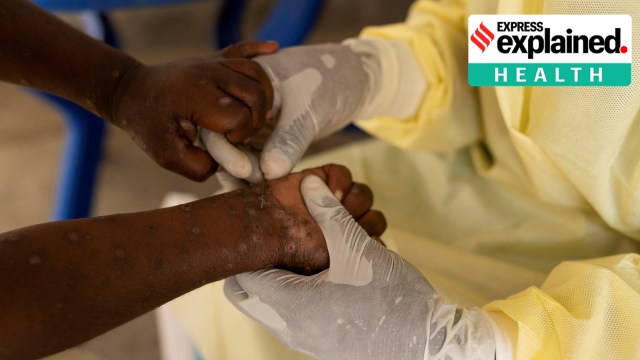
What is mpox?
Mpox, previously known as monkeypox, is a self-limiting viral infection caused by mpox virus (MPXV). The most common symptoms of mpox include fever, headache, muscle aches, back pain, low energy, and swollen lymph nodes, along with pox-like rashes that last for two to three weeks. It is a self-limiting disease but can lead to death, especially among children and those with weak immune systems.
While the infection has been reported in humans since 1970, it mostly affected people in the endemic regions in Africa till 2022.
What is driving the current concern around Mpox?
The current concern stems from the spread of clade Ib of the MPXV, which is predominantly transmitted through sexual contact.
Organisms belonging to a clade share common ancestors. When it comes to mpox, there are two different clades: clade I and clade II, with the former deadlier than the latter.
Sexual transmission of clade I infections has not been reported previously, according to a paper published this January in the journal Emerging Infectious Disease. Historically, clade I infections have spread through zoonotic spillover events — transmitted from animals to humans in close proximity. Clade Ia infections that spread this way continue to affect parts of DRC where the disease was endemic.
Story continues below this ad
Now, over 100 cases of clade 1b infections have been reported in four countries neighbouring DRC — Burundi, Kenya, Rwanda and Uganda — that have not reported mpox before. The numbers are likely to be higher as many with symptoms might not have been tested. This is coupled with an increase in the total number of mpox cases. More than 15,600 cases and 537 deaths have been reported so far this year alone.
“The emergence of a new clade of mpox, its rapid spread in eastern DRC, and the reporting of cases in several neighbouring countries are very worrying. On top of outbreaks of other mpox clades in DRC and other countries in Africa, it’s clear that a coordinated international response is needed to stop these outbreaks and save lives,” WHO Director-General Dr Tedros Adhanom Ghebreyesus said on Wednesday.
Research published in the journal Nature late last year indicates that recent cases are being driven by human-to-human transmission, and that the virus has diversified into several distinct lineages in the human population, where it is fast acquiring many new mutations.
Is India at risk?
The first case of the more contagious clade Ib mpox infection outside Africa was reported from Sweden on Thursday. With interlinked global travel, the cases may reach other countries as well.
Story continues below this ad
During the 2022 global outbreak, India too reported cases of mpox, albeit of the less deadly clade II type. Initially, infections were reported among some people from Kerala who had a history of international travel. But later even those without a history of international travel got infected in Delhi. At least 27 laboratory confirmed cases and one death was reported in India, according to the WHO data.
IHR Emergency Committee Chair Professor Dimie Ogoina said, “The current upsurge of mpox in parts of Africa, along with the spread of a new sexually transmissible strain of the virus, is an emergency, not only for Africa, but for the entire globe. Mpox, originating in Africa, was neglected there, and later caused a global outbreak in 2022. It is time to act decisively to prevent history from repeating itself.”
Are there vaccines for mpox?
There are at least two vaccines currently in use for mpox, which have been recommended by the WHO’s Strategic Advisory Group of Experts on Immunization.
Last week, an Emergency Use Listing for mpox vaccines was triggered by the WHO, which will accelerate vaccine access for lower-income countries which have not yet issued their own national regulatory approval. This listing also enables bodies such as GAVI and UNICEF to procure vaccines for distribution in these countries.
Story continues below this ad
WHO is working with countries and vaccine manufacturers on potential vaccine donations, and coordinating with partners through the interim Medical Countermeasures Network to facilitate equitable access to vaccines, therapeutics, diagnostics and other tools, the organisation said.
During the previous outbreak in 2022, India too had called on companies to manufacture vaccines and diagnostics.








































